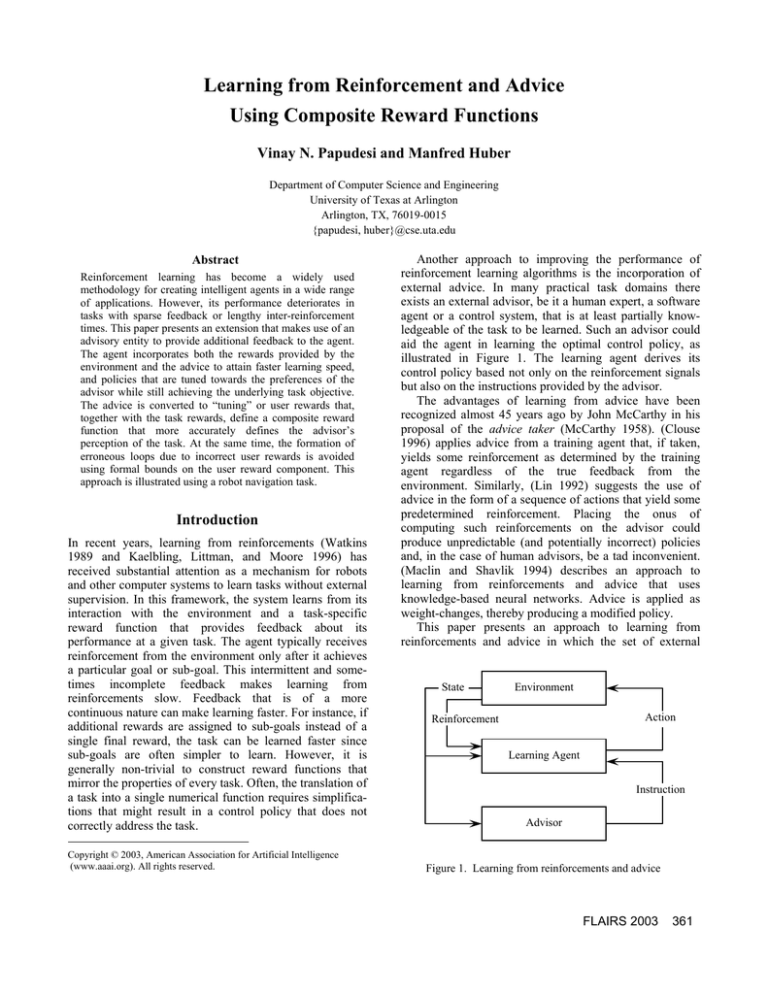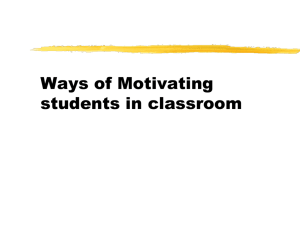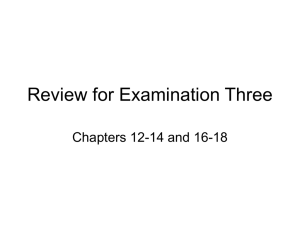
Learning from Reinforcement and Advice
Using Composite Reward Functions
Vinay N. Papudesi and Manfred Huber
Department of Computer Science and Engineering
University of Texas at Arlington
Arlington, TX, 76019-0015
{papudesi, huber}@cse.uta.edu
Abstract1
Reinforcement learning has become a widely used
methodology for creating intelligent agents in a wide range
of applications. However, its performance deteriorates in
tasks with sparse feedback or lengthy inter-reinforcement
times. This paper presents an extension that makes use of an
advisory entity to provide additional feedback to the agent.
The agent incorporates both the rewards provided by the
environment and the advice to attain faster learning speed,
and policies that are tuned towards the preferences of the
advisor while still achieving the underlying task objective.
The advice is converted to “tuning” or user rewards that,
together with the task rewards, define a composite reward
function that more accurately defines the advisor’s
perception of the task. At the same time, the formation of
erroneous loops due to incorrect user rewards is avoided
using formal bounds on the user reward component. This
approach is illustrated using a robot navigation task.
Introduction
In recent years, learning from reinforcements (Watkins
1989 and Kaelbling, Littman, and Moore 1996) has
received substantial attention as a mechanism for robots
and other computer systems to learn tasks without external
supervision. In this framework, the system learns from its
interaction with the environment and a task-specific
reward function that provides feedback about its
performance at a given task. The agent typically receives
reinforcement from the environment only after it achieves
a particular goal or sub-goal. This intermittent and sometimes incomplete feedback makes learning from
reinforcements slow. Feedback that is of a more
continuous nature can make learning faster. For instance, if
additional rewards are assigned to sub-goals instead of a
single final reward, the task can be learned faster since
sub-goals are often simpler to learn. However, it is
generally non-trivial to construct reward functions that
mirror the properties of every task. Often, the translation of
a task into a single numerical function requires simplifications that might result in a control policy that does not
correctly address the task.
Copyright © 2003, American Association for Artificial Intelligence
(www.aaai.org). All rights reserved.
Another approach to improving the performance of
reinforcement learning algorithms is the incorporation of
external advice. In many practical task domains there
exists an external advisor, be it a human expert, a software
agent or a control system, that is at least partially knowledgeable of the task to be learned. Such an advisor could
aid the agent in learning the optimal control policy, as
illustrated in Figure 1. The learning agent derives its
control policy based not only on the reinforcement signals
but also on the instructions provided by the advisor.
The advantages of learning from advice have been
recognized almost 45 years ago by John McCarthy in his
proposal of the advice taker (McCarthy 1958). (Clouse
1996) applies advice from a training agent that, if taken,
yields some reinforcement as determined by the training
agent regardless of the true feedback from the
environment. Similarly, (Lin 1992) suggests the use of
advice in the form of a sequence of actions that yield some
predetermined reinforcement. Placing the onus of
computing such reinforcements on the advisor could
produce unpredictable (and potentially incorrect) policies
and, in the case of human advisors, be a tad inconvenient.
(Maclin and Shavlik 1994) describes an approach to
learning from reinforcements and advice that uses
knowledge-based neural networks. Advice is applied as
weight-changes, thereby producing a modified policy.
This paper presents an approach to learning from
reinforcements and advice in which the set of external
State
Environment
Action
Reinforcement
Learning Agent
Instruction
Advisor
Figure 1. Learning from reinforcements and advice
FLAIRS 2003
361
instructions is used to sculpt a reward function that more
accurately represents the advisor’s view of the task,
resulting in the learning of a potentially different control
policy. Instructions serve two purposes—the acceleration
of the learning process and the tuning of the reward
function, which can alter the manner in which the task is
solved, and possibly the task itself.
In this paper, a robot navigation task will be considered.
Here, reinforcement learning and advice will be used to
learn paths to target locations in a hybrid topological/
geometric path planning framework. Policies are learned in
a connectivity graph where nodes represent significant
locations, referred to as via-points, and connected nodes
can be reached using geometric control primitives.
Simple and Composite Reward Functions
The construction of an appropriate reward function for a
specific task is generally difficult. Often, the agent derives
a large positive reward when it reaches an accepting state.
In the example navigation task, a task reward function
would assign a fixed positive reward to the goal states. A
similar navigational task might also include a set of viapoints which the robot must avoid. This information can be
captured by assigning negative rewards to these states.
More complex reward structures can be created by
assigning rewards to intermediate states or state-action
pairs. For instance, a particular navigation task might
assign a positive reward to actions that represent a passage
through a door or corridor. This provides the robot with a
heuristic similar to “doors and corridors are a means of
reaching distant goals.” Incorporating this information into
the reward function can be seen as fine-tuning the policy.
Negative rewards play a similar role.
Adding intermediate rewards and punishments to tune a
policy is generally non-trivial and can easily result in the
formation of a policy that does not perform the task
correctly. One way of countering this involves determining
upper and lower limits for the reward that may be applied
to each state-action pair such that it does not lead to the
formation of loops. However, some tasks require the
formation of loops. For instance, the optimal policy for a
robot that secures and patrols a building and reports when
it detects a burglar would involve repeatedly cycling
through the rooms of the building. It would therefore seem
appropriate to differentiate between the task reward
function and the “tuning” reward function, referred to
within this text as the user reward function. These two
components together define the reward function, where the
task reward function is fixed a priori while an external
advisor can define the user reward function. Throughout
learning, the system ensures that cycles are not created due
to modified user rewards.
The Task of Navigation
Composite rewards are used to learn the sample task of
mobile robot navigation. It is important to note that while
362
FLAIRS 2003
Key:
Linkage via-point
Obstacle
Free space
Via-point
Visual features
Connectivity graph
Figure 2. Representation of a sample environment
this paper develops and applies the technique of learning
from reinforcements and advice in the context of navigation, it is also applicable to tasks that may be correctly
described by reward functions.
The task assigned to the mobile robot is to learn to
optimally navigate to a specific target. The environment
consists of a set V of via-points on a set W of maps, linked
together through a subset of V representing the linkage viapoints. Each map is a 50×50 grid of square cells1. Figure 2
shows a sample environment consisting of four maps or
100×100 cells. The via-points are linked together to create
a connectivity graph that identifies valid paths.
Actions are specified as instances of a geometric
motion controller with a particular goal. Goal specifications here consist of subsets of via-points representing
absolute locations or locations of recognizable visual
features. These actions directly handle the continuous
geometric space by computing a path to one of the given
goal locations, if such a path exists.
The abstract state space S of the learning agent is the set
of via-points V. The maximum number of controllers in
this state space is 2|S|–1, as the set of goals G for each
controller can include any combination of the |S| states.
The number of controllers can be reduced to |S| by
restricting the goal of each controller to a single via-point.
This set of controllers represents the action space A.
1
The choice of a 50×50 grid is related to the use of harmonic potentialbased motion controllers (Connolly and Grupen 1992, Connolly and
Grupen 1996) to traverse via-points.
The target of a specific navigation task can be a
particular via-point in V or a visual feature from the set of
recognizable visual features F. The size of the set F and
the complexity of the visual features depend on the
capability of the robot’s camera and image processing
modules. Targets represented by via-points are directly
reachable by at least one controller. However, controllers
are only applicable from a limited number of states.
Targets represented by visual features are reachable
through their closest via-points. When the robot detects a
visual feature at a particular via-point, it stores the viapoint–feature pair in the model for future reference.
Learning from Reinforcements and Advice
The steps involved in taking advice from external entities
were defined (Hayes-Roth, Klahr and Mostow 1980) as:
1.
2.
3.
4.
5.
Request the advice,
Convert the advice to an internal representation,
Convert the advice into a usable form,
Integrate the reformulated advice into the agent’s
current knowledge base, and
Judge the value of the advice.
The first step decides what entity initiates the provision
of advice. This paper assumes that the advisor initiates the
provision of advice. This assumption is based on
convenience for human advisors.
Often, instructions are provided in a form that is
comprehensible to only the advisor (typically a human)
and requires the reformulations made in steps 2 and 3. In
the example presented here, the advice itself is in the form
of states and state-action pairs. A recommendation of the
state-action pair (s, a) leads to a preference for action a in
state s. A recommendation of the state s leads to a
preference for the path of state-action pairs starting at the
current state and ending at s. The set of recommended
states and state-action pairs is mapped onto a numerical
function, bias : S × A × (V ∪ F ) → ℵ . If ns represents the total
number of actions available at state s and T ∈ (V ∪ F )
represents the task, bias is defined as:
bias T ( s, a ) + n s − 1 If a is the recommended action,
If a is an alternative action,
biasT ( s, a ) ← biasT (s, a) − 1
biasT (s, a)
Otherwise.
This definition of the bias function ensures that the
numerical bias applied to each state-action pair is zero if
all ns actions at state s are recommended equally often. The
notion behind this construction is that an advisor that
recommends all possible actions at a state is most likely
unaware of the true best action(s).
Step 4 varies with the learning approach and internal
representation scheme used. In this work, the bias function
is transformed into the user reward component rυ ,T ( s, a ) of
the composite reward function. This transformation is
defined as:
sB
γ nR
sA
γ n +1 R + r
rυ ,T
Figure 3. A simple loop.
rυ ,T ( s, a) =
(
)
f 1 s, a, T , ω * (biasT ( s, a ))
f 2 (s, a, T , ω* (biasT ( s, a)))
0
If biasT ( s, a) is positive,
If biasT ( s, a) is negative,
Otherwise.
Here, ω * and ω* are weighting functions. Their purpose
is to vary the applied user reward with the user bias. For
example, consider the following instances of f 1 and ω * :
f1 ( s, a, T , ω * ) = kω *
ω * ( x) =
and
x
1+ x
The value of the weighting function ω * increases with
the user bias towards an asymptotic value of one. If the
user bias is positive, the applied user reward f1 would be
in the range [k 2 , k ) .
Finally, in step 5, the agent must analyze how the
external advice has altered its performance, and
accordingly retain, alter or dispose of it. A typical example
is the avoidance of erroneous loops. In the work presented
here, analytic limits on the user rewards are derived to
avoid such misleading advice.
The User Reward Function
The user reward component associated with a particular
state-action pair is directly related to the bias function. The
sign of the bias indicates if the state-action pair has been
recommended or discouraged, while the magnitude indicates how often the state-action pair has been recommended or discouraged.
Upper Bound for User Rewards
An important decision is the numerical value of the user
reward. To preserve the task and speed up learning, it has
to be ensured that the value is not so high as to lead to the
formation of self-sustaining loops. Figure 3 illustrates such
a case. The following analysis assumes a task reward
function with a single final task reward and no
intermediate rewards or punishments. It further assumes
that the action selection mechanism is deterministic and
based on the Q-value function, where Q( s, a ) represents
the value of a state-action pair as the expected sum of
discounted future rewards if action a is taken in state s and
the optimal policy is followed afterwards (Watkins 1989).
However, the results also apply to probabilistic models.
State s B is closer to the task goal T than s A and has a
higher value. The Q-value of the state-action pair ( s B , a s )
A
FLAIRS 2003
363
after convergence is γ QT ( s A , a s ) , where γ is the discount
fac-tor and the notation a t represents an action that leads
to state t. A loop is formed if this value is larger than the
value of state sB. To ensure that no loop forms, the
following inequality must hold:
B
γ (γ n +1 R + rυ ,T ) < γ n R
Simplifying this inequality and solving for rυ ,T results in:
(
)
n −1
rυ ,T < 1 − γ 2 γ R
This upper bound for the user reward is correct under
the assumption that no other state-action pair receives a
reward. In general, both the task and user reward
components may have positive and negative intermediate
reward assignments. In this more general case, an upper
bound for the user reward can be can be derived as12:
rυ ,T ( s, a ) < (1 − γ ) QT ( s, a ) − rτ ,T ( s, a )
This limit is used to judge the advice in order to prevent
the formation of spurious loops and thus to preserve the
original task objective.
Lower Bound for User Rewards
Consider a value function that is strictly increasing.
Negative rewards have the effect of reducing the values of
the predecessor states. Certain assignments of negative
rewards can invalidate this property. For example, any
cycle of states can be made to form a loop by assigning
sufficiently large negative rewards to all actions that leave
the cycle. If there are no rewards within the loop, the
values associated with the state-action pairs that form the
loop decay to zero. If there are negative rewards within the
loop, the values of the corresponding state-action pairs
decay to a fixed negative value that is a function of the
negative rewards and the discount rate. However, if every
state has at least one action that is assigned a non-negative
reward, then the values of state-action pairs in the loop
decay to zero. A lower bound for user rewards can
therefore be computed as the value that causes the value of
the best action to become zero. When the user reward
drops below this limit, the corresponding values become
zero or less, and (potentially) lead to the formation of
loops. In the presence of intermediate task rewards, a
lower bound for the user reward is:
rυ ,T ( s, a ) > − max QT ( s, b) − rτ ,T ( s, a )
b∈ A
The Learning Algorithm
An algorithm for learning from reinforcement and advice
is shown in Table 1. It learns an optimal control policy for
a task T.
The algorithm makes dynamic programming updates on
the Q-value and user reward functions. The Q-value of
each state-action pair ( s, a t ) depends on the probability that
2
A detailed derivation of this bound can be found in (Papudesi 2002).
364
FLAIRS 2003
Table 1. Learning from reinforcement and advice
LEARN-WITH-USER-REWARDS (task T):
Initialize:
i←0
i
t
For each state-action pair ( s, a t ) , do rυ ,T ( s, a ) ← 0
Repeat forever:
i ← i +1
For each state-action pair ( s, a t ) , do:
1. Determine the composite reward rT ( s, a t ) :
t
a. Compute rυ ,T ( s, a ) according to biasT ( s, a t )
i
t
i −1
t
t
i −1
t
b. rυ ,T ( s, a ) ← rυ ,T ( s, a ) + α υ (rυ ,T ( s, a ) − rυ ,T ( s, a ) )
c. rT ( s, a ) ← rτ ,T ( s, a ) + rυ ,T ( s, a )
2. Compute the components of QT ( s, a t ) :
a. δ succ ( s, a t ) ← rT ( s, a t ) + γ QT (t , arg max QT (t , b) )
t
t
i
t
b∈ A
t
b. δ fail ( s, a ) ← γ QT ( s, a t )
t
t
t
3. QT ( s, a ) ← P (t | s, a ) δ succ ( s, a )
t
t
+ (1 − P(t | s, a ) ) δ fail ( s, a )
action a t leads to state t. The correct value of this
probability, P (t | s, a t ) , is discovered as the agent explores
the state space. An incremental user reward update scheme
is essential for oscillation-free convergence of the user
reward function (Papudesi 2002).
Experimental Results
This section presents the application of the LEARN-WITHUSER-REWARDS algorithm. The quadruple of user reward
transformation functions used to obtain these results are:
f 1 ( s, a, T , ω * ) = ω * ((1 − γ ) QT ( s, a ) − rτ ,T ( s, a ) ) ,
f 2 ( s, a, T , ω* ) = max(ω* , − maxt QT ( s, b) − rτ ,T ( s, a) ) ,
b∈ A−{a }
x
ω ( x) =
1+ x
*
and
ω* ( x) =
x
10
The weighting function ω * for positive user biases tends
towards one as the user bias increases. On the other hand,
ω* causes the user reward to decrease by 0.1 with each
recommendation of a different state-action pair. The user
reward functions f1 and f 2 enforce the upper and lower
bounds to prevent the formation of loops.
Figure 4 shows the different paths taken by the agent.
The initial and final via points are represented by the circle
and cross, respectively. Without any external advice, the
agent takes the shortest path to the target which is path (a).
When the state-action pair ( s, a t ) (marked as 1 in the
figure) is recommended by the advisor, path (b) is
preferred, as a result of the newly introduced user rewards.
The prevention of loops is shown by issuing a second
instruction that recommends the state-action pair (t , a s ) ,
marked as 2 in Figure 4. The agent now takes path (c) and
avoids the formation of the expected loop. Figures 5 and 6
t
1
s
2
a, c
u
b
Path (a)
Path (b)
Path (c)
Figure 5. Changes in the user reward function due to advice.
Path (a)
Path (b)
Path (c)
Figure 4. Paths taken by the agent with and without advice.
illustrate the changes in the user reward and Q-value
functions due to the two instructions.
Advice intended to tune the policy may be used to
specify the preferred path to a via-point. However, the
upper and lower bounds on the user rewards prevents
advice from changing the task itself. Experiments to this
effect were successfully performed.
The learning process is generally accelerated by the
provision of advice, the exception being advice that is
intended to modify or tune the policy. The actual speed-up
in the learning process is derived in (Papudesi 2002).
Conclusion
The results presented in this paper illustrate the potential of
learning from reinforcement and advice using user
rewards. By incorporating advice into an additional reward
function, its independence from the task is ensured. As a
result, the advisor is provided with a high degree of
freedom in shaping the control policy, but cannot prevent
the achievement of the overall task. Furthermore,
strategically provided advice can accelerate the learning
process, while incorrect advice is ultimately ignored, as its
effects diminish over time.
Acknowledgments
This work was supported in part by NSF ITR-0121297.
References
Clouse J. A. 1996. Learning from an Automated Training Agent.
In Weiβ, G. Sen, S., Adaptation and Learning in Multiagent
Systems, Springer Verlog, Berlin.
Figure 6. Changes in the Q-value function due to advice.
Connolly, C. I., and Grupen, R. A. 1996. Harmonic Control. In
Proceedings of the 1992 International Symposium on Intelligent
Control.
Connolly, C. I., and Grupen, R. A. 1992. Applications of
Harmonic Functions to Robotics. In Proceedings of the 1992
International Symposium on Intelligent Control.
Hayes-Roth, F., Klahr, P., and Mostow, D. J. 1980. Advicetaking and knowledge refinement: An iterative view of skill
acquisition. Technical Report, Rand Corporation.
Kaelbling, L. P., Littman, M. L., and Moore, A. W. 1996. Reinforcement learning: A survey. Journal of Artificial Intelligence
Research, 4, 237–285.
Lin, Long-Ji 1992. Self-improving reactive agents based on
reinforcement learning, planning and teaching. Machine
Learning, 8, 293-321.
Maclin, R., and Shavlik, J. W. 1994. Incorporating advice into
agents that learn from reinforcements. In Proceedings of the
Twelfth National Conference on Artificial Intelligence, 694–699,
MIT Press.
McCarthy, J. 1958. Programs with common sense. In Proceedings of the Symposium on Mechanisation of Thought Processes,
volume 1, 77–84, London.
Papudesi, V. N., 2002. Integrating Advice with Rein-forcement
Learning. M.S. thesis, Department of Computer Science, Univ. of
Texas at Arlington.
Watkins, C. J. C. H. 1989. Learning from delayed rewards. PhD
thesis, Psychology Department, Univ. of Cambridge.
FLAIRS 2003
365






